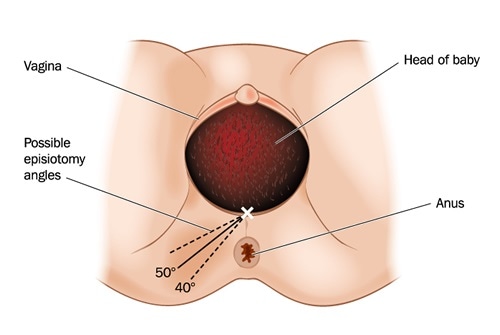An episiotomy procedure is done so that the opening of the vagina can be made larger to facilitate the birth of a baby.
An incision is made in the perineum, the portion between anus and the opening of the vagina, whenever the opening of the vagina does not stretch sufficiently for the baby to come out. When the head of the baby is stretches to several centimeters in the vaginal opening, physicians usually perform an episiotomy.
After placental delivery, physicians stitch the incision. Awareness about the necessity for the procedure, expected results, risks and benefits, and possible complications will be helpful in researching alternative procedures.

Need for Episiotomy
During childbirth, tissues can be stretched naturally. Physicians will suggest how the stretching can be done.
The body of women can be strengthened for labor by practicing Kegel exercises, controlling breathing, and performing perineal massage 4–6 weeks prior to delivery, which can reduce the need for episiotomy.
Physicians may have several reasons to suggest an episiotomy, as mentioned below:
- Fetal distress—a condition in which the baby suffers due to lack of sufficient oxygen
- Complicated baby positions such as breech (the baby takes up feet first position) or shoulder dystocia (the shoulders of the baby are trapped)
- Labor pushing stage is long
- Premature baby
- Large baby
- Vacuum delivery or delivery requiring forceps
There could be tearing of perineal tissues without episiotomy, which can be difficult to repair.
Types of Episiotomy
Episiotomy is categorized into several types depending on parameters such as beginning location of the incision, the incision direction, length of the incision, and the precise procedure time.
Episiotomy procedure is categorized into seven types:
- Median or medial episiotomy (midline incision): The incision starts at the fourchette and gets extended to half the length of the central tendon of perineum.
- In the modified median type, the incision is done in the subcutaneous tissues (and not in the skin) transversely.
- In J-shaped episiotomy, the incision begins at midline and is later directed in the direction of ischial tuberosity resembling a ‘J’ shape.
- The initial location of the incision in the lateral episiotomy is about 1–2 cm from the midline and the direction of the incision is toward ischial tuberosity.
- Radical lateral is the same as lateral episiotomy except one variation in the direction of the incision—starting from midline the incision is directed toward ischial tuberosity and in the region of the rectum. It is recommended in complicated deliveries.
- Posterolateral (mediolateral) episiotomy incision begins within 3 mm from midline and is directed laterally toward ischial tuberosity at about 60 degrees.
- Anterior episiotomy starts at midline and the incision is directed in the direction of pubis.
Studies have found that the type of episiotomy has an impact on perineal trauma. Perineo-anthropometric research has discussed about the angle of incision, angle of the suture, and the angle of the scar involved in the types of episiotomy.
Post Episiotomy
Episiotomy can create complications such as bleeding, swelling, infection, pain during sexual intercourse, and anal sphincter muscle and rectal tissue tears (passing stools will be controlled). Blood may get collected in the perineal tissues; in addition, there is a possibility of other risks depending on the health condition.
Stitches will stop bleeding. It may take up to 1 month for the stitches to heal. When the stitches are exposed to fresh air, it can assist in healing. In some cases, the scar tissues around the place of incision can be itchy.
The episiotomy procedure will cause pain in the place of incision. Studies have found that severe pain happens in about 1% of women with episiotomy, which affects their daily activities and quality of life.
To alleviate pain and swelling, ice pack may be used. For speedy healing and to ease soreness, medicated creams, pain numbing sprays, and cold or warm shallow baths are suggested. Upon physician advice, pain relievers can also be taken.
Keeping the place of incision and the nearby area clean and dry is important to prevent infection. Pouring warm water in the vaginal area for rinsing after going to toilet will help to ease any discomfort. Instead of a sitting posture, squatting position during urination will reduce the sense of “stinging.”
When painful bowel movements are experienced, physicians may prescribe stool softeners. There could be limitations on certain activities such as lifting heavy materials or carrying out strenuous activity, sex, and use of tampons and on diet unless otherwise accepted by the physician.
Pelvic exercises could help in healing, as they strengthen the muscles around the anus and vagina and decrease pressure on the incision and nearby tissues.
If women have chills or fever, severe perineal pain, swollen or red skin (infection), vaginal discharge with foul smell, or bleeding from the place of incision, discussion with physician will help to get instructions on care depending on the condition.
Sources
- www.hopkinsmedicine.org/.../
- https://medlineplus.gov/ency/patientinstructions/000482.htm
- books.google.com/books
- fxF_A&hl=en&sa=X&ved=0ahUKEwjw_Jaa9NrVAhWDgI8KHRMCBEA4ChDoAQhPMAk#v=onepage&q=Midline%20or%20median%20incision.%20episiotomy&f=false
- books.google.com/books?id=2qTCDAAAQBAJ&pg=PA71&lpg=PA71&dq
- http://www.nhs.uk/Conditions/pregnancy-and-baby/pages/episiotomy.aspx

0Comments